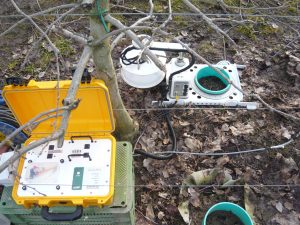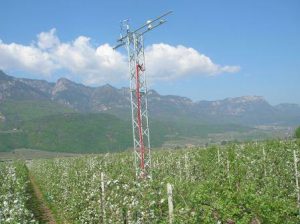Carbon fluxes and carbon farming

We study the net exchange of CO2 between perennial fruit tree systems, like apple orchards and vineyards, and the atmosphere. Our aim is to assess their role as sink or source of atmospheric carbon and to predict the effects of climate changes on the C fluxes. For this purpose, we use eco physiological and micrometeorological approaches, combining fluxes detected by an eddy covariance (EC) station with those deriving from soil respiration chambers and biometric measurements, as well modelling approaches.
The carbon budget of the apple orchard

We have recorded for 10 consecutive years the C fluxes using eddy covariance technique in an apple orchard, as well as the lateral C fluxes deriving from the biomass entering (organic fertilizers) or leaving (fruit production) the ecosystem. This allowed us to understand the climatic and factors influencing ecosystem carbon sink capacity.
The carbon budget of the vineyard
The eddy covariance equipment is currently measuring net CO2 exchange in an organic vineyard. Fundamental differences exist between the apple and vineyard cropping systems, due to different crop-phenology, training system, crop height and density with consequences on light interception and system productivity. A goal of our research activity is to support EC data with other type of measurements (chambers, biometric, meteorological) to disentangle the contribution of the herbaceous and vine component in relation to seasonal, climatic and management factors.
Carbon footprint
The activities characterizing the biological capacity of fruit-tree agro-ecosystems to sequester C are complemented by a life cycle assessment of the release of CO2-equivalent during the different phases of the production cycle in.